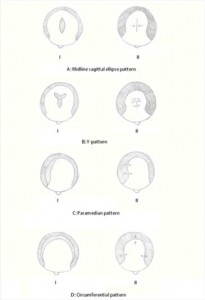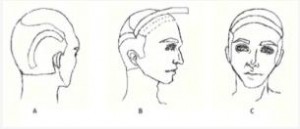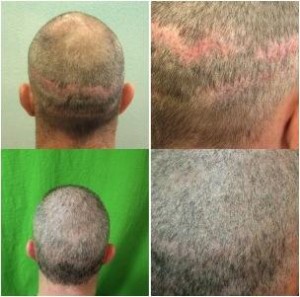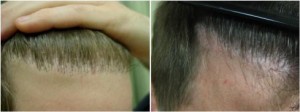Hair has always had deep sociological significance and held diverse meaning throughout recorded history. For men, a full head of hair signifies virility and youth, while denoting sexuality and beauty for women. Hair loss carries a meaning of just the opposite, with aging and unattractiveness as the forerunning associations. Thus, men and women have been searching for a hair loss cure for many years. And in places where cosmetics are of supreme importance, like Los Angeles, hair restoration is a precious resource.
The pinnacle of surgical hair restoration technology today is hair transplant. This surgery entails the removal of healthy hair grafts (follicular units) from their natural place of growth (the donor area), to be implanted into the balding recipient area. Follicular units are comprised of one to four naturally-growing clusters of hair, and the donor area is traditionally the rear and sides of the head.
But it didn’t start off with hair transplant. First, there were other methods of hair restoration, some of which are still in use today, and others that aren’t.
EVOLUTION OF HAIR RESTORATION SURGERY
In the great city of Los Angeles, hair restoration surgery has become a highly developed art and skill among transplant surgeons. But this wasn’t always so. Hair transplant has evolved through a number of research and developmental stages itself, and before that were the following:
- -Scalp reduction
- -Temporoparieto-occipital flap surgery
SCALP REDUCTION
Scalp reduction is the surgical excision of the bald area, after which the hair-bearing skin is brought together and stitched closed. This is only applicable for crown hair loss and frequently results in severe scarring, slot formation, scar expansion, necrosis and hyposthesia. Though it is a highly invasive and antiquated method with regard to hair restoration, it is still used for other medical purposes, such as congenital birth defects.
TEMPOROPARIETO-OCCIPITCAL FLAP SURGERY
Flap surgery addresses hairline recession by cutting two hair-bearing flaps from the rear-side of the head, harnessed by the foremost edge of skin, and rotating them to the front. The flaps can be up to 24cm in length, enough to span the anterior hairline, however this has become a far less popular method of Los Angeles hair restoration due to several risk factors. Risks include scarring, converse direction of hair growth, hyposthesia, injury of the spinal accessory nerve, an elevated periauricular at the posterior hairline and around the ears.
HAIR TRANSPLANTATION
Hair transplant surgery started in Japan in the early 1900s. From there, it progressed as such:
- -Punch grafting
- -Mini-/miro-grafts
- -Strip harvesting
- -Follicular unit extraction
- -Body hair transplant
Past Hair Transplant Methods
Punch grafting and mini-/micro-grafting are methods of the past. Norman Orentriech M.D., an American doctor, introduced the punch graft to Western medicine based on earlier Japanese findings. Highly divergent from Los Angeles hair restoration standards of today, the developing punch graft of the time created a 4mm-round excision by 1952, under Orentriech’s practice.
However, by the mid-1970s, it became apparent that this punch size was far too large to appear remotely natural. The unsightly outcome coined the term “hair plugs,” and “doll’s hair,” as it resembled the hair of a doll. People associated this negative stigma with hair transplant for decades to follow.
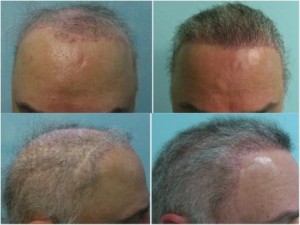
Antiquated methods, including punch-grafting and jury flaps, corrected at Los Angeles hair restoration practice, DermHair Clinic.*
Today’s Hair Transplant Methods
Current methods include strip harvesting, follicular unit extraction, and body hair transplant. Many Los Angeles hair restoration clinics practice work in all three or specialize in the advanced practice of just one or two.
Strip harvesting, also known as follicular unit transplant, is today’s most common method. It cuts out a linear strip of flesh from the mid-occipital part of the scalp to be later dissected into follicular units for implantation. This procedure doubtless produces a linear scar, or “strip scar,” that has the capacity to stretch over time. However, the recently developed tricophytic closure coerces hair to grow through the linear scarring. A less apparent scar would result.
Among Los Angeles hair restoration specialties, follicular unit extraction has gained notoriety as the most sophisticated. Also known as FUE, this method harvests the donor hair by excising the follicular units one at a time. The punch size has shrunken from the antiquated 4mm down to .8-1.2mm. This avoids the linear scar altogether and creates only negligible, diffuse scarring. It is the ideal surgery for someone who wears his hair short, so as to be unconfined to the necessity for long hair that a strip scar demands.
Only a highly proficient and experienced Los Angeles hair restoration surgeon should perform FUE. The procedure is long, labor-intensive, and demands expert skill for successful execution. The results are more refined than FUT, including the capacity for advanced hairline design and the use of non-traditional donor hair.
Body hair transplant, or BHT is the most modern and advanced form of surgical hair restoration. A derivation of follicular unit extraction, BHT allows for the excision of donor hair from almost anywhere on the body. This includes the beard, shoulders, chest, abdomen, legs, and arms. Largely pioneered by Los Angeles hair restoration surgeon, Dr. Sanusi Umar, this method serves the purpose of restoring severely bald patients whose donor supply is otherwise depleted. Sometimes a combination of traditional and non-head hair is used to achieve the maximum outcome in density, design, long-term graft survival, and texture.
Tomorrow’s Hair Transplant Methods
Automation and robotics are the proposed future of surgical hair restoration. The idea is to improve speed and efficiency; however, it is arguable that only a human-run procedure can evaluate and adjust to the varying expanse of individual patient need. If they haven’t already, many Los Angeles hair restoration clinics will soon implement:
- -The Choi Implanter
- -The NeoGraft
- -ARTAS
First, the Choi Implanter is a graft-loading implanter. It is touted as hands-free when, ironically, the grafts must be loaded into the implanter by hand. This creates just as much if not more work for the surgeon and his/her staff.
Next, the NeoGraft is an excision tool that excises the hair and then removes it by way of an air vacuum into a holding depository. While this is intended to simplify the harvest, the air threatens to dry out the grafts, thus compromising their survival.
A third device used in Los Angeles hair restoration clinics is the ARTAS. This is a robotic device that runs the entire excision process on 3-D imaging software, a mechanical arm, a 1.65mm needle punch device, and a user interface. The larger punch of this device inevitably creates greater wounding and scarring, and its automation poses a threat to transection rates.
Other complications, such as cyst formation, graft burial, and heightened transection rates may be a problem with any automated hair transplant device.
HAIR CLONING AS A HAIR RESTORATION PROSPECT
Several attempts have been made to develop a viable method of cloning hair. Despite the best efforts of hair restoration research and worldwide science, all attempts have fallen short. However, doctors, surgeons, scientists, and the like are hopeful for a future in which hair cloning is a global resource, eliminating the possibility of a depleted donor source.


